Evidence for advanced architectural planning at the early prehistoric site of Dhaskalio in the Aegean
Four-year research programme ends uncovering the sophisticated architectural remains of an advanced civilisation
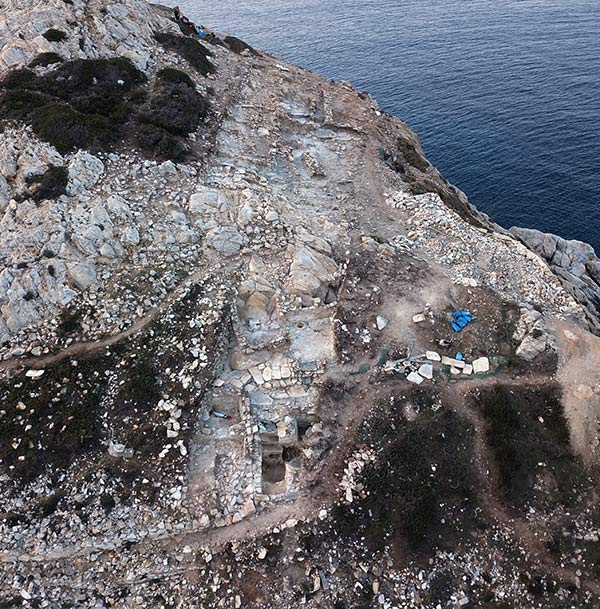
Aerial view of sophisticated prehistoric public architecture uncovered at Keros, Greece.
Image credit: Cambridge Keros project
Archaeologists from the University of Cambridge, the Ephorate of the Cyclades and the Cyprus Institute have completed their four-year programme of excavations at the settlement adjoining the prehistoric sanctuary on Keros in the Cycladic Islands of Greece, the earliest maritime sanctuary in the world (2750-2240BC).
They have uncovered a series of impressive stairways, drainage systems and stone-built structures revealing a sophisticated urban architecture unprecedented for the period. The settlement, on what is now the small island of Dhaskalio, was originally linked by a narrow causeway with the nearby location at Kavos at the west of Keros, where remarkable quantities of broken marble sculptures and vessels, along with much broken pottery, had been ritually placed in two ‘Special Deposits’ over a period of some five hundred years.
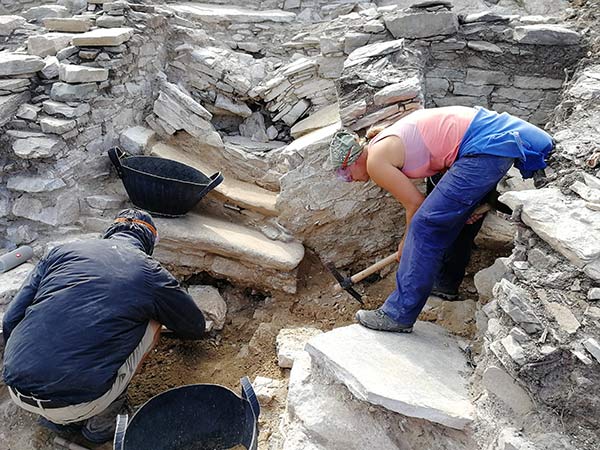
Excavation in Trench B at the staircase. Image credit: Cambridge Keros Project
The four-year programme of work (2015-2018) by the Cambridge Keros Project, under the auspices of the British School at Athens, follows the excavations conducted from 2006 to 2008 at Kavos in which the remarkable marble finds from the Special Deposit South were recovered. Some of these sculptures had originally been as much as a metre tall: the context of their discovery revealed that they had been deliberately broken in other islands of the Cycladic Archipelago, and brought to Kavos for formal disposal in a series of rituals which are now gradually being clarified by the new excavations.
The finds from the 2018 excavations add greatly to our knowledge of the Dhaskalio settlement, which flourished during the Cycladic Early Bronze Age, as radiocarbon dates have confirmed.
Steep paths ascended to the summit, traversing massive platforms constructed to provide flat space for building. The intricate, interconnected and multi-level architecture gives a clear impression of a planned and well-built settlement, established on a steep promontory. The buildings on Dhaskalio were constructed mainly of good quality marble which had to be brought by sea from the island of Naxos, some ten kilometres to the north, since good quality marble is not available on Keros.
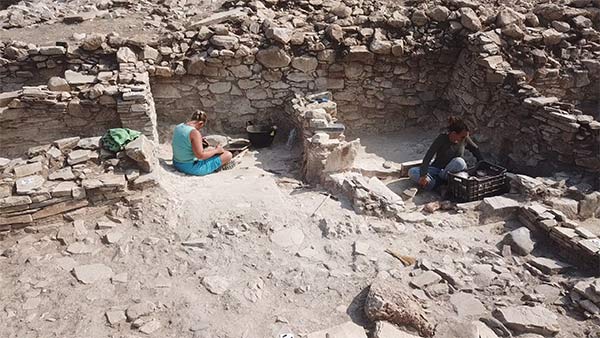
Sampling and recording in Trench A. Image credit: Cambridge Keros Project
Professor Colin Renfrew of the University of Cambridge and co-director of the excavation, explains: “At Dhaskalio we see a number of sophisticated architectural techniques employed in a well-thought through manner. These include massive entranceways, stone-flagged stairways, and an intricate drainage system covering the entire island. This gives the clear impression of a skilled architect and a guiding hand planning and executing a building programme whose scope can only be compared with a site like Knossos on Crete.”
The import of marble from Naxos is only one indication of the seafaring abilities of the builders of Dhaskalio. Tools made from blades of obsidian, a volcanic glass imported from the Cycladic island of Melos, confirm that the islanders were accomplished sailors. Every single one of the 101,313 potsherds was imported from elsewhere, indicating a vast sea-going network spanning the entire Cycladic archipelago and beyond.
But, perhaps most notable of all the imported materials are the metals.
Amongst the most significant finds this year are installations for the casting of copper artefacts – axes, chisels and pins, as well as spearheads and daggers. Traces of copper slag found on potsherds in many parts of the site, confirm that metallurgical work was underway in many areas.
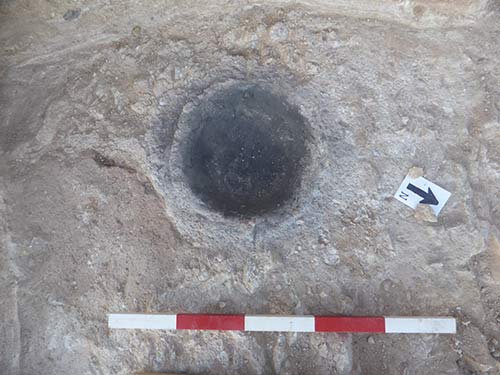
An intact metalworking hearth from 2500 BCE at Keros, Greece. Image credit: Cambridge Keros Project
Dr Michael Boyd of the University of Cambridge and co-director of the excavation, notes that “One of the unique features of this site is the way that metalworking seems to be a feature from the very beginning until the end. It is one of the most identifiable activities on the site, practised almost everywhere we’ve dug. Metalworking on this scale presumes a constant supply of raw materials from the western Cyclades or Attica, and social structures that allowed for learning and maintaining esoteric technical skills.”
“But, most importantly, where was all the finished product going? It seems likely that part of the point of the seafaring networks centring on Dhaskalio was the circulation of finished metal products like daggers.”
Scientific approaches and the use of new technologies are at the heart of the project, both opening new avenues for research, and also offering the results of analyses much faster than was possible in the past. A host of environmental studies, from the identification of burnt seeds and charcoal to the identification of microscopic plant remains (called phytoliths) or the traces of animal and plant oils and starches on potsherds and ground stone tools, are leading to a new understanding of the agricultural economy and the landscape of the site.
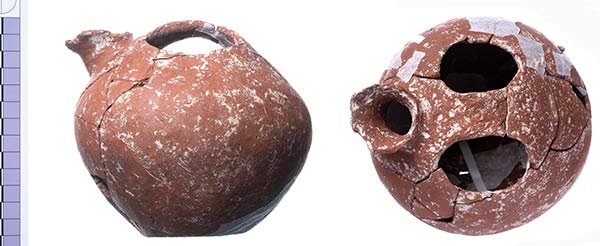
Askos with preformed apertures from Trench C. Image credit: Cambridge Keros Project
Dr Evi Margaritis of the Cyprus Institute, lead researcher for the organic remains from Dhaskalio (and assistant director of the project), says “The island of Keros is itself not a good prospect for supporting a thriving site like Dhaskalio. All the evidence we are seeing is that much of the foodstuffs used on the site were imported to the site. This implies an agricultural hinterland stretching out to nearby islands and is further evidence of Dhaskalio’s position at the top of a networked hierarchy of sites.”
The nearest location with significant agricultural potential is the island of Kato Kouphonisi, some 5km northwest of Keros and a calling point on the route to the much larger and agriculturally rich island of Naxos. During the 2018 field season, from 3rd September to 13th October, it was also possible to conduct surface survey on Kato Kouphonisi, which is today sparsely inhabited. Clear settlement remains of several periods were recognised from surface indications and from the accompanying potsherds. One site at the south of the island is the nearest Early Bronze Age settlement to Dhaskalio. The team believes that Kato Kouphonisi was just as important to Dhaskalio as its own island hinterland on Keros.
The Cyprus Institute co-organised for a third year an educational programme during the 2018 excavations with the University of Cambride. Students from Greece, Australia, New Zealand, the USA, Canada, and the UK joined the excavation and gained valuable experience of up-to-the-minute excavation and scientific techniques. The syllabus epitomised the twin goals of promoting science in archaeology and establishing the highest standards of teaching and research. The Cyprus Institute was also involved in the 3D documentation of the site and the reconstruction of the site through virtual reality.
The excavations have resolved the enigma brought about by the major episode of looting at Kavos on Keros in the years prior to 1963, which resulted in the appearance on the illicit market in antiquities of many Cycladic sculptures. When authorised excavations began in 1963 the breakages in the material recovered was at first attributed to the carelessness of the looters, and the complicated history of the sanctuary has only gradually become clear. Now with the thorough examination of the accompanying settlement, the nature of the sanctuary has become clearer. It can now be understood as a regional centre for the entire Cycladic Island group.
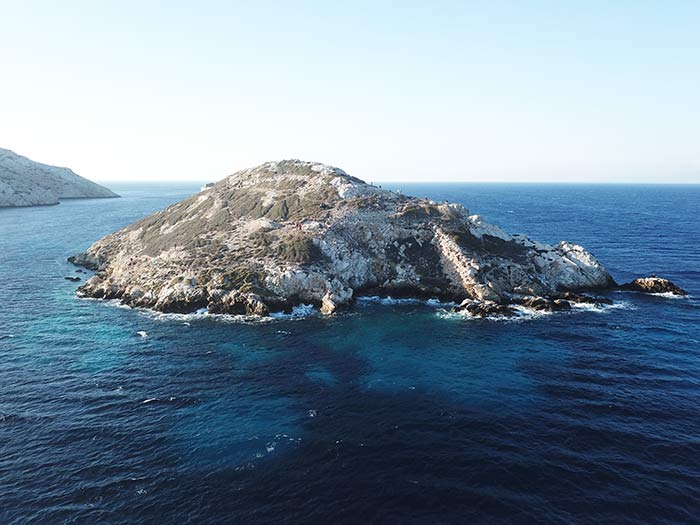
View of Dhaskalio from the north during the excavations. Image credit: Cambridge Keros Project
ENDS
The project is organised under the auspices of the British School at Athens and conducted with permission of the Greek Ministry of Culture and Sport, with the support of the Director of the Ephorate of the Cyclades, Dr Dimitris Athanasoulis. The project is directed by Colin Renfrew and Michael Boyd of the McDonald Institute for Archaeological Research, University of Cambridge. The Associate Director is Irini Legaki of the Ephorate of the Cyclades. Assistant Directors are Evi Margaritis, Giorgos Gavalas, Jill Hilditch and Josh Wright. Ioanna Moutafi was field director. The project is supported by the Institute for Aegean Prehistory, the A.G. Leventis Foundation, the Stavros Niarchos Foundation, the Cyprus Institute, the McDonald Institute for Archaeological Research, Research Promotion Foundation, the British Academy, the Society of Antiquaries of London, the Gerda Henkel Stiftung, National Geographic Society, Cosmote, Blue Star Lines, EZ-dot and private donors.